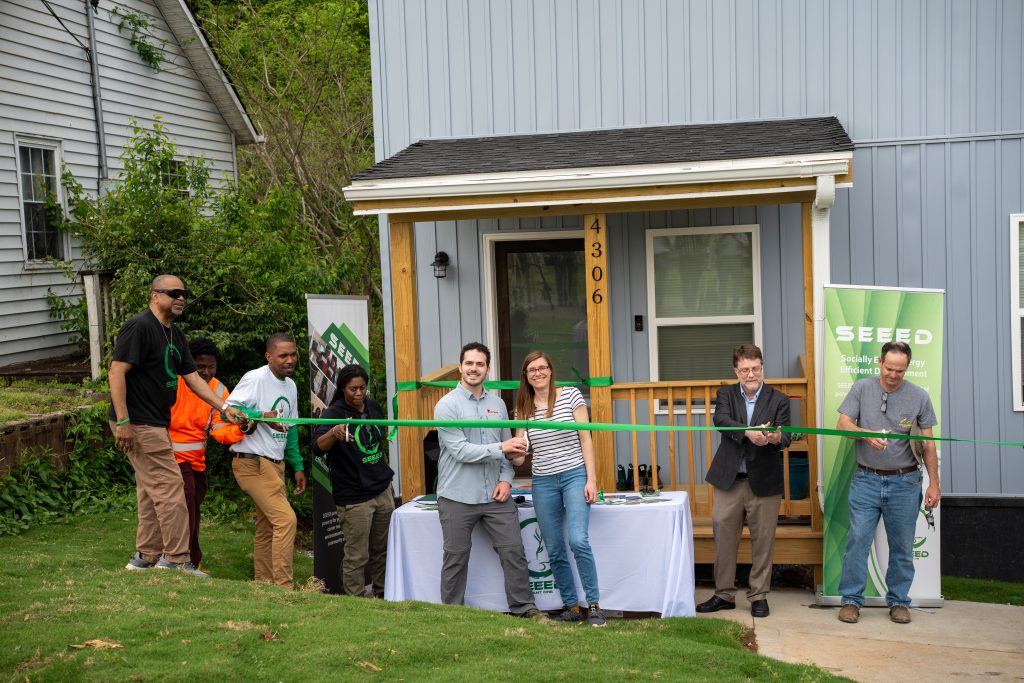Paradise Protected
Passing by the road to Raven Ridge, high in the Clinch Mountains of Virginia, it is hard to believe that this steep, winding route was the focal point of a battle that raged up and down the mountain for four years. Today, visitors lucky enough to discover this little-known Appalachian treasure are rewarded with breathtaking views and magnificent sculpted sandstone formations, as well as a campground and resort that are among the finest in the southern mountains. After a getaway at Raven Ridge, guests will be grateful to the owners, Charles and Alona Kennedy, for their hospitality. But visitors owe the Kennedys a much larger debt, for it is largely due to their courage and determination in the face of threats and violence that this place has been protected.
When you first meet Charles Kennedy, one word immediately comes to mind—strength. He walks as though he’s been riding a rough trail for years, and his steely blue eyes seem accustomed to seeing into distances most people can’t imagine. Perhaps the most wonderful thing about this Texan jack-of-all-trades is his openness, his willingness to tell his story and to listen to the stories of everyone he meets.
Kennedy’s far-sightedness and openness could perhaps be a consequence of living so high in the mountains. At approximately 3700 feet, Kennedy is sure that he and his wife Alona are the highest living full-time residents in all of Virginia. The view from Raven Ridge, despite the summer haze, is breathtaking, sweeping far into the Clinch Valley and Hayter’s Gap. Campers who arrive on a summer evening are welcomed by the rich sounds of cicadas, treefrogs, and katydids. And under the graceful roof of Whippoorwill Lodge, wondrous luxury awaits those who wish to partake of the Lodge’s fully-equipped kitchen, generous hearth, and outdoor hot tub. Kennedy built this lodge with his own hands, and his careful work is reflected in the salvaged maple floors (rescued from an old school gym) and the stone chimney and mantels which are inset with fossil and mineral finds from his travels throughout the Southwest. In the morning at Hummingbird Café, B&Bers are treated to a delightful organic and occasionally wild-crafted breakfast by Alona, who works as a pastry chef in town. In the summer, hummingbirds visit the feeders at the Café by the hundreds.
All of these wonders would not still be possible were it not for the Kennedys’ determination to keep their land. Charles Kennedy had originally come to this place to rejuvenate himself after a lifelong struggle with a rare blood disorder which had, in turn, led to a battle with drugs and alcohol. He dreamed of a place he could belong to, and when the 103-acre property which comprises Raven Ridge came on the market, he jumped at the chance. This place also allowed him to meet Alona, with whom he began correspondence shortly after meeting mutual friends down the mountain in 2000.
The Fight To Save a Mountain
He arrived in his paradise, innocent as a lamb of the struggle into which he’d thrown himself. Unknown to them, the adjacent 4800 acre property of Brumley Mountain had been a local point of contention for years. Bill Wasserman, a neighbor of Kennedy’s, had been quietly attempting to keep the mountain from harm for almost a decade before Kennedy arrived. Kennedy soon found himself embroiled in a struggle that would last four years and nearly ruin him and his wife emotionally, financially, and physically.
Brumley Mountain has changed hands many times over many years. Originally known as the Upchurch Property, it had been logged once, so that the value of its timber lay in smaller trees which could be used for making pallets. This was the primary interest of Edwards Wood Products, a North Carolina pallet-making company that bought the land on September 7, 2001. Besides providing pallet timber, the mountain property had many other potential benefits. Slate could be mined to make beautiful floor tiles. Rare white sandstone could be blasted out of the rocks at the top of Brumley Mountain, and would be perfect for making glass, especially for car windshields. The company had also proposed development of a private, gated community to the Washington County Planning Commission that would split the property into 19 tracts.
Enter Charles Kennedy. The .7 mile road that curves up to Raven Ridge is the only viable access to Brumley Mountain. He first met two of the developers as they perused plans on their car trunk on his road. When he asked them what they were doing, they replied that they were “driving down their road.” He quickly disabused them of the notion. When Kennedy learned of what the developers planned, his indignation at their trespassing turned quickly to alarm. He stayed on the phone for almost 48 hours, trying to reach anyone who would listen to his plight. Three activist groups, including the Poor Valley Coalition, were formed almost overnight by phone for the mountain’s defense. Kennedy also learned in short order how to use a computer and the Internet to find vital information for his cause. The residents of the valley were not unaccustomed to these kinds of dilemmas. Twenty years ago, they fought a protracted battle against APCO (now AEP) to stop a dam that would have flooded a large part of the valley. They knew how to mobilize in tough times, and many of them responded in kind to Kennedy’s request for aid.
Edwards Wood Products soon applied to the Planning Commission of Washington County regarding their plans for the subdivision. This would include building a private road up the mountain which would allow the company access from Rt. 80 to its timbering and mining sites. Charles Kennedy held the only other possibility for access if he would grant the company right-of-way, which he had thus far refused to do. But the Planning Commission and, subsequently, the Board of Supervisors were not interested in another private subdivision, as they had already encountered too many road maintenance and service issues with a similar, existing subdivision. They denied Edwards Wood Products permission to go forward with its proposal. As soon as the Board’s position was clear, the company sent a boy across the room to deliver a lawsuit to Kennedy. “They already knew the outcome,” he notes, “and they were ready to go.” Because the County had denied Edwards Wood Products their own private road, the company claimed it was entitled to Kennedy’s right-of-way.
A few landowners who had cabins towards the end of the road to Brumley Mountain disagreed with Kennedy. Because they only owned the property adjacent to the road, they could do nothing about the right-of-way. Many of them turned to fear tactics. Kennedy endured beatings, being shot at three times, having his mailbox blown up, and consistent lockouts by those unsympathetic to his cause. When the fear mongers began harassing Alona by following her as she went back and forth to work, breaking her windshield, and spray-painting vulgar epithets on downed logs, Kennedy’s desire to block them at any cost was reinforced. His strategy was simple. He attended every public hearing and made phone calls to everyone who might have influence or insight into ways to save Brumley Mountain. When he experienced problems with outfitting his own property with sewer lines, he used this adversity to demonstrate to the public that a development such as that proposed on Brumley Mountain would never work. Proper sewer lines would be almost impossible to install, and due to the mountain’s soil composition, would cause sewage runoff that could impact those living downhill. Since the road proposed by Edwards Wood Products did not meet state standards, Kennedy asked, what would the people of the county do if trouble came in the future? He showed the public where this development would hurt them the most—their wallets. And he was tireless in this demonstration of old-fashioned common sense. “What I want people to know,” he says, “is that anyone can do what I’ve done, as long as they have the will to do it.”
After so much abuse, he and Alona had seriously considered selling out in late 2003. In addition to all that was going on at Raven Ridge, Alona’s home village in the Philippines was threatened by a developer who wished to drive out all the people and tear the village down. Alona’s cousin felt that he couldn’t hold out against the developers much longer, and Alona was frantic to know what to do. But the Kennedys woke up the next morning thinking of the Great Channels. These sandstone labyrinthine formations at the top of Brumley Mountain are believed to be around 420 million years old, the shore of a long-dead ocean. Bands of color slide down the planes and angles as the rock weathers. White sand, the very sand prized for making car windshields, drifts in piles across the loamy floor of the maze. Kennedy has named many of the formations here. One he calls the elephant is plainly visible at the junction of one of the pathways with its downturned mouth and curling trunk. Moss and lichen drip across the sheer faces, accompanied by century-old rhododendrons clasping the slick surface. Thinking about this place, the Kennedys looked at one another and realized they just couldn’t sell.
On March 30, 2004, three years after Edwards Wood Products took over the property from the Upchurch Corporation, the Nature Conservancy bought the Brumley Mountain site. Kennedy, as he noted in the Coalition for Jobs and the Environment newsletter, was “in a state of shock.”
Kennedy has been praised (and cursed) by many for his bulldog-like tenacity in the face of so many obstacles. But ever the humble activist, he shies away from claiming all the credit for this environmental success story. “I truly owe a debt of gratitude to the people of Poor Valley and the Nature Conservancy,” he said. “They came through for this place when it needed them most.”
The Future of Brumley Mountain
The fate of Brumley Mountain and the Great Channels is still tenuous. Poachers, both of ginseng and of black bears, still actively roam the property. In places where ginseng should be abundant, it is often completely absent. Kennedy has repeatedly had to protect his own herb patch with a shotgun. Kennedy has also found an illegal bear-baiting bucket that has obviously been visited by bears and regularly baited by hunters. In addition, the Nature Conservancy seems ambivalent about how it will use the property. The group paid $3.5 million for the property, a price it could ill-afford. Matthew Crum, area director for the Nature Conservancy, stated in a press release on the date of the property purchase that the organization may at some point transfer the land to a state agency or private conservation manager. Such statements suggest that Brumley Mountain may not be out of the woods yet.
However, there is greater hope these days than there was three years ago. Rain continues to weather the Channels into a fascinating, mystical labyrinth. Trees mature over patches of black and blue cohosh. Kennedy also managed to purchase Alona’s village by putting his land in a conservation easement and selling the tax credits. He gave the purchase money to her at Christmas 2003. “And if things here don’t work out, well then I guess we’re off to fish on the beach,” he says, laughing.
Ever the optimist, Kennedy refuses to be daunted by dark times. He has managed to balance looking towards the future with living in the moment. And right now, Charles and Alona Kennedy wait at Raven Ridge to welcome new visitors to the place they call home.
Related Articles
Latest News
More Stories

Leave a comment
Your email address will not be published. Required fields are marked *




